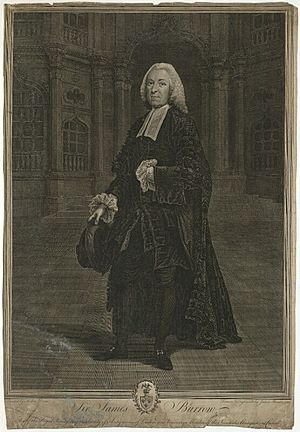James Burrow facts for kids
Quick facts for kids
James Burrow
FRS FSA
|
|
|---|---|

Engraving of Burrow by James Basire
|
|
| 17th and 19th President of the Royal Society | |
| In office 1768–1768 |
|
| Preceded by | James Douglas |
| Succeeded by | James West |
| In office 1772–1772 |
|
| Preceded by | James West |
| Succeeded by | Sir John Pringle |
| Personal details | |
| Born | November 28, 1702 Starborough Castle, Lingfield, Surrey, England, UK |
| Died | 5 November 1782 (aged 80) |
Sir James Burrow (28 November 1701 – 5 November 1782) was an important English scholar. He worked as a legal reporter in London. He was also a leader at the Royal Society, a famous science group. He even became president of the society twice! He was made a knight in 1773.
Contents
Life and Work
Joining the Royal Society
Sir James Burrow joined the Royal Society on April 7, 1737. This group was for people interested in science and math. He was seen as someone "well versed in Natural and Mathematical knowledge."
He was part of the Royal Society's main council for many years. He served from 1752 until 1782. He started as a vice president in 1752.
Leading the Royal Society
Sir James became the temporary president of the Royal Society twice. The first time was from October to November 1768. This happened after the death of The Earl of Morton.
He was president again from July to November 1772. This second time was after the death of James West.
Helping with Science Projects
As a leader, Sir James helped the Royal Society with big projects. One important project was watching the Transit of Venus in 1761. This is when the planet Venus passes in front of the Sun.
He helped send scientists like Charles Mason and Jeremiah Dixon on a trip. They went to Bencoolen on the island of Sumatra. Their job was to observe this rare event.
Being a Legal Reporter
Sir James was also a legal reporter. This meant he wrote down important court decisions. At that time, four reporters were officially chosen by the King. Their job was to record what was said in court. They also wrote down the reasons for the judgments.
His work helped people understand important legal cases. His reports are still used today in law courses.
See also


